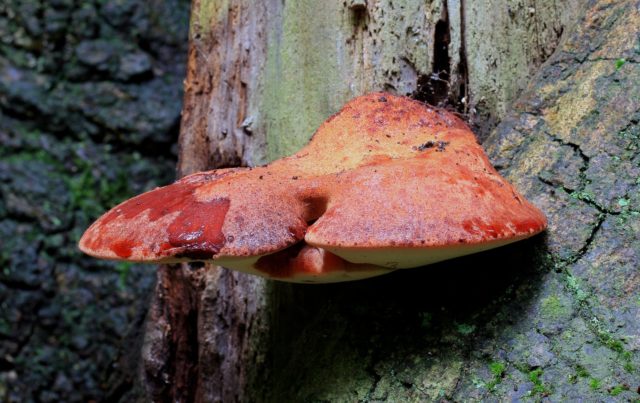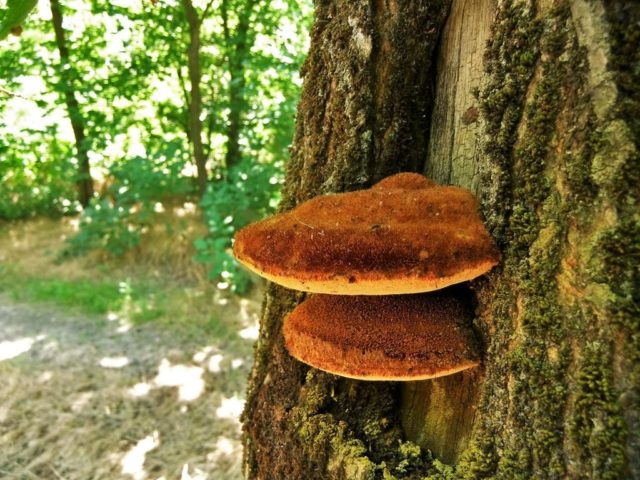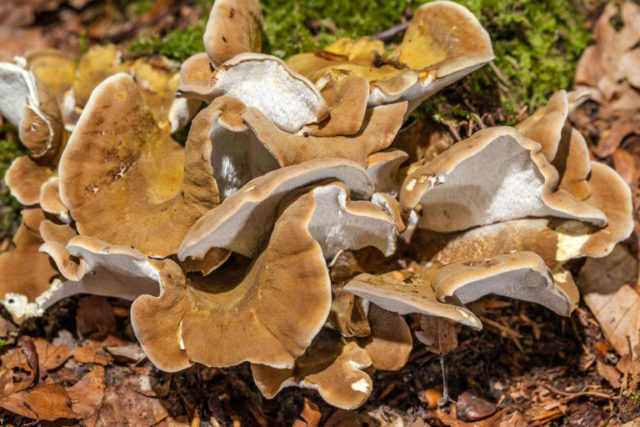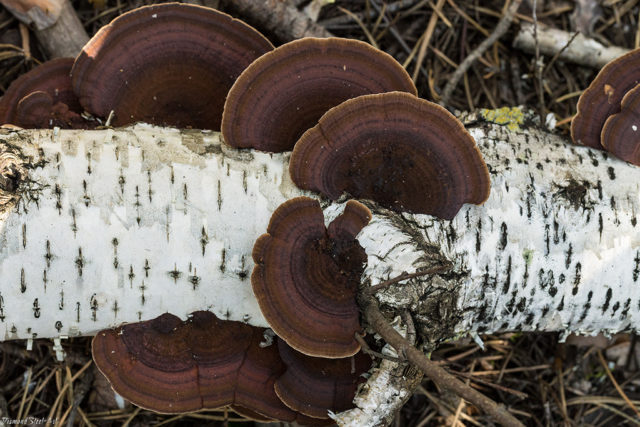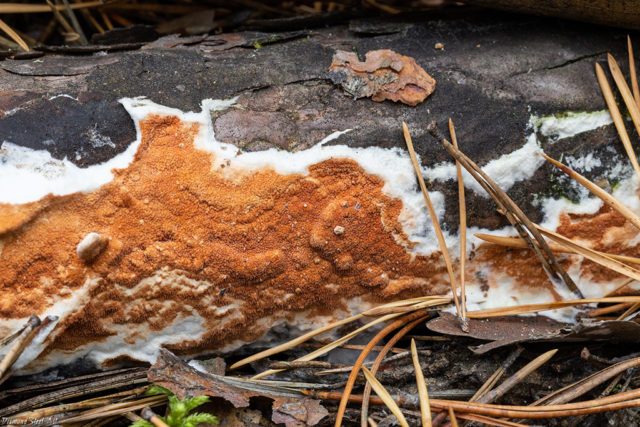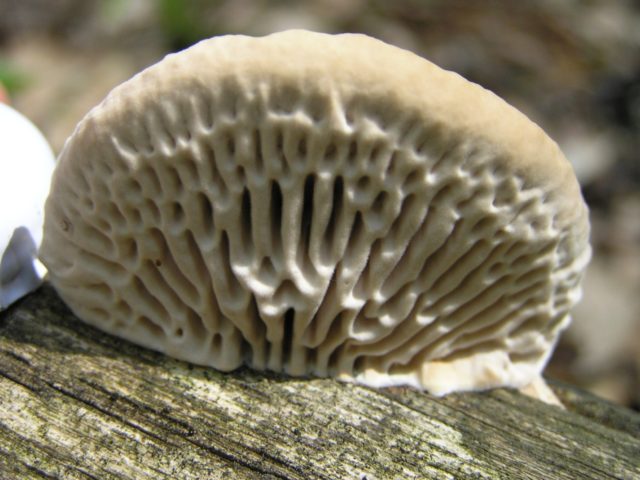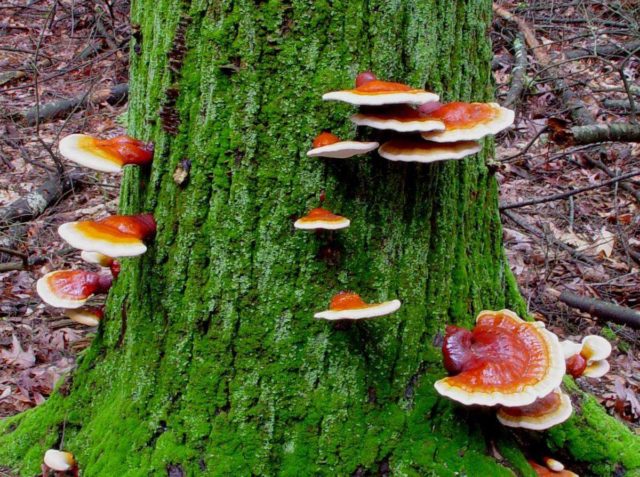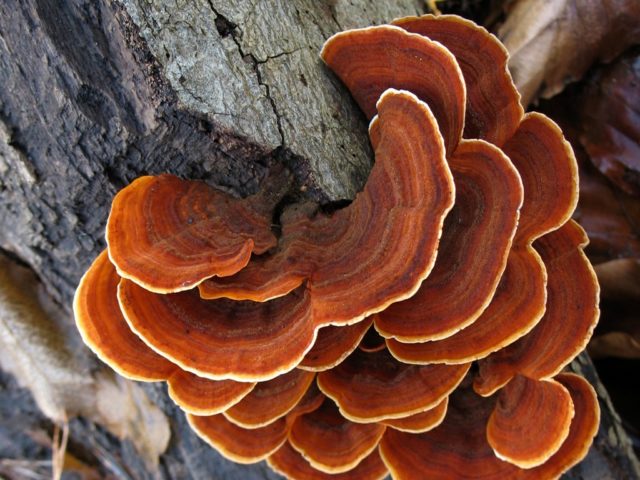Content
Polypores are fungi that grow on the trunks and skeletal branches of living and dead trees, as well as in their roots. They are similar in the structure of fruiting bodies, type of nutrition, methods of reproduction, but belong to different orders, families. The name unites many species, which are saprotrophs on dead wood and parasites on living wood. The photos of the tinder fungus presented in the article demonstrate an amazing variety of colors, sizes and shapes.
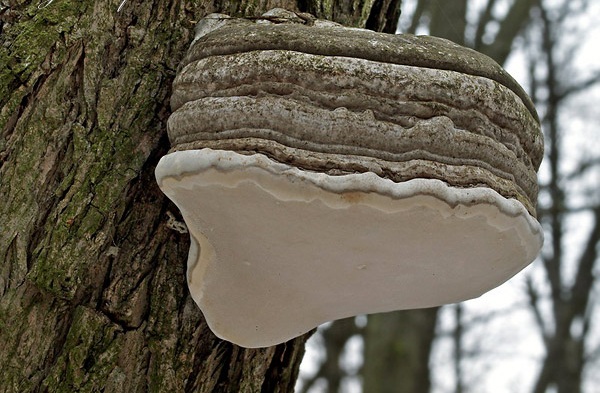
Tinder real
What does a tinder fungus look like?
The appearance of tinder mushrooms is very diverse. In size, they can be from a few millimeters to 100 cm in diameter, weighing from a few grams to 20 kg. Fruiting bodies can consist of one cap, the edge of which is attached to the substrate, or have a full-fledged or rudimentary stem. In shape, the caps can be open, prostrate-bent, hoof-shaped, cantilever, fan-shaped, spherical, nodular, shelf-shaped, bent shell-shaped, disc-shaped.
Depending on the type and age, the thickness of the caps differs. Their surface can be smooth, bumpy, wrinkled, velvety, fleecy, matte or glossy, covered with a crust or skin.

Larch polypore hoof-shaped
Algae or moss often settle on the surface of the caps. Colors can be muted, pastel or bright. The core is called fabric or tram. She may be:
- soft - waxy, fleshy, subgelatinous, fibrous, spongy;
- tough - leathery, cork, woody.
Sometimes the fabric is two-layer, consists of soft and hard layers. Its structure can change during the development of the fungus. The color of the tram varies in the range of white, gray, beige, yellow, brownish, brownish, pinkish tones. The hymenophore of polypore mushrooms is of different types:
- tubular;
- labyrinthine;
- lamellar;
- toothed;
- spiny.

Types of hymenophore of polypore mushrooms
In perennial species, with age or under the influence of the environment, there is an age-related transformation of one type of hymenophore into another. The pores can be regular and irregular in shape, the same size and different sizes. Spores vary from cylindrical to spherical, whitish, grayish in color.
Where does the tinder fungus grow
Polypores grow in any part of the planet Earth where there are trees. They settle on different parts of living and felled trees, processed wood - timber, wooden buildings.
They can be found in forests, gardens, parks, in suburban areas and in cities. Few tinder fungi live on living trees: most members of the genus prefer dead wood. The habitat of tinder fungi spans temperate and tropical regions, but there are also varieties that live in more severe climates.
Features of a tinder fungus
Among tinder fungi, there are both annual and perennial varieties. They are divided into 3 categories:
- Annualsdeveloping during one growing season. The lifespan of such tinder fungus does not exceed 4 months; with the onset of winter, they die.
- Annual wintering - tolerate winter well and resume reproduction of spores in the next season.
- Perennial - living for 2-4 years or 30-40 years and annually increasing a new layer of the hymenophore.
Polypore mushrooms are not "omnivorous", they are specialized in tree species. There are very few highly specialized varieties among them, most are focused on a certain type of wood, for example, conifers or broad-leaved species. In each locality, a certain tinder fungus affects 1-2 tree species.
The structure of the tinder fungus
The tinder fungus consists of a mycelium and a fruiting body. The mycelium develops inside the woody body, spreading along its entire length. Before the formation of fruiting bodies, the mushroom does not betray its presence in any way. Tinder fungi grow slowly, first forming tubercles or flat spots on the surface. Then they gradually increase in size, acquire the form inherent in this type.
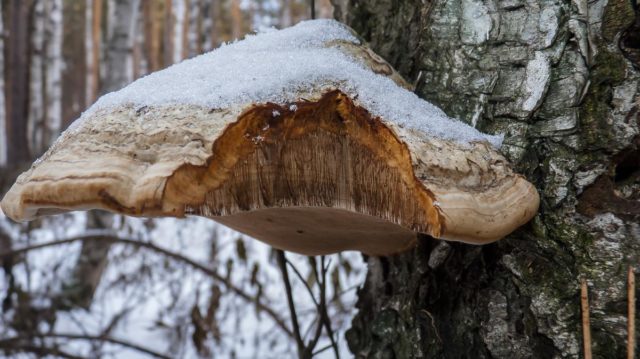
Sectional polypore: hymenophore, tissue, crust are clearly visible
The fruit body of the tree fungus is formed by the interlacing of many hyphae filaments of various lengths and thicknesses. The hyphal system of tinder fungi can be:
- monomic - consisting only of generative hyphae;
- dimitical - formed by generative and skeletal or connecting hyphae;
- trimic - formed by generative, skeletal and binding hyphae.
Many species of polypores are characterized by the annual reproduction of a new hymenophore with a gradual overgrowth of the old hyphae. In this case, the body of the fungus is formed by annual ridges, which can be used to determine its age.
The development of the fungus is influenced by climatic conditions and the location of the substrate. Favorable weather stimulates their rapid growth and proper development. The moisture level plays a major role here. With a sufficient amount of it, the fruit bodies become darker, acquire a contrast of colors. In dry weather, on the contrary, they brighten, thinner, dry, the pores are smoothed and tightened. For this reason, the fungus can form several layers of the hymenophore in one season.
Type of food tinder fungus
All polypore mushrooms feed on wood. They have the ability to degrade the cellulose and lingin they need, for which their mycelium or hyphae produce the appropriate enzymes. Depending on their composition, various types of rot appear on the wood: white, brown, red, variegated, soft. The wood changes color, becomes brittle, stratifies parallel to the growth rings, and loses in volume and mass. If a tinder fungus has settled on an old, diseased, dry plant, it acts as a forest orderly, accelerating the transformation of the latter into soil. If the host tree is young and healthy, the tinder fungus parasitizes on it, destroys it within 5-10 years.
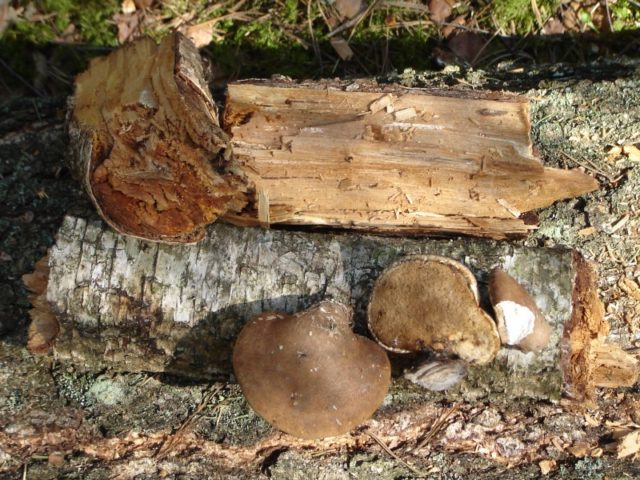
Sound-sapwood rot of wood caused by the vital activity of tinder fungus
How tinder fungus reproduces
Polypores reproduce by spores, infection occurs by air. Spores get deep into the tree trunk through damage to the bark, formed as a result of exposure to severe frosts and winds, animal damage, and human activities. There they attach themselves, sprout with mycelium, which gradually grows, destroying the tree from the inside. The fruiting bodies are the small, visible part of the fungus. Most of it is inside the trunk. With this method of reproduction and development, it is impossible to detect a tinder fungus at an early stage. It grows imperceptibly in the heart of the tree and manifests itself as a fruiting body even when the plant is almost impossible to save.
Types of tinder fungus
Tinder fungi belong to the class Basidiomycetes, a subclass of Holobasidiomycetes, in which several families are distinguished:
- Fistulin (Fistulinaceae) - are included in the Agaric order, combine saprophytic mushrooms with fruiting bodies in the form of a shelf. A striking representative of the family is the so-called liver mushroom (Fistulina hepatica) - an edible species of tinder fungus.
Liverwort ordinary
- Amylocorticoid (Amylocorticiaceae) - representatives of the order Boletovye, form flat fruiting bodies. These include fragrant and flesh-pink amylocorticium, small-spore and creeping ceraceomyces, plikaturopsis.
Curly plicaturopsis
- Hymenochetes (Hymenochaetales) - combines inedible species of woody fungi. Annual and perennial fruiting bodies are colored yellowish-brown, dark gray, have a hard cork or woody tram. Includes the genus Fellinus, Inonotus, Pseudoinontus, Mensularia, Onnia, Coltricia.
Inonotus bristly-haired
- Schizoporic (Schizoporaceae) - includes 14 genera and 109 species. Fruit bodies are one- and perennial, prostrate or prostrate-bent, repeating the configuration of the substrate, painted white or brownish, flat, adherent, growing on the underside of dead wood. The hymenophore is smooth or cracked, with rounded or irregular pores, sometimes teeth.
Strange schizopora
- Albatrell (Albatrellaceae) - edible tinder fungi, included in the order Russulales. Fruiting bodies are annual, consist of a flat-depressed cap, whitish, yellowish or brownish in color, and a short, thin, cylindrical stem. They grow under coniferous trees, form mycorrhiza with them. Only young mushrooms are eaten.
Albatrellus crested
- Polyporous (Polyporaceae) - form semi-shaped growths on trees. The flesh is often soft at a young age, becoming very tough over time. The hymenophore is tubular or labyrinthine. Includes edible and inedible mushrooms.
Dedaleopsis tricolor
- Phanerochetaceous (Phanerochaetacaeae) - form crust-like or lingual open fruit bodies up to 15 cm in diameter and up to 1.5 cm thick, often forming a kind of "whatnot" on the bark. The hymenophore is prickly. The flesh is thin, leathery or fibrous, inedible.
Irpex milky white
- Merulievs (Meruliaceae) - fruiting bodies spread over the substrate or ascending, annual, soft. Some species form a well-developed cap. The surface of the fungus is smooth or pubescent, painted in whitish or brownish tones. The hymenophore can be smooth, prickly, folded.
Gleoporus yew
- Fomitopsis (Fomitopsidaceae) - perennial fruiting bodies sessile or prostrate, often hoof-shaped, massive. The tissue is leathery, woody or cork, the hymenophore is tubular, layered. Annual mushrooms are often bushy, multi-capped, edible.
Oak sponge
- Ganoderm (Ganoderma) - includes 2 types of mushrooms: with a matte and oily-shiny surface. Fruit bodies are capped or capped, have a cork or woody structure.
Lacquered polypore (reishi mushroom)
- Gleophilous (Gleophillum) - forms annual or perennial fruiting bodies in the form of a horseshoe or rosette. The surface of the mushroom can be smooth or fleecy, brown or gray. The hymenophore is tubular, labyrinth-like or lamellar.
Stereum
The classification of polypores by mycological scientists shows significant controversy. The same mushrooms in different researchers may belong to different groups.
Are tinder fungi edible
When collecting mushrooms, many people bypass tinder fungi, not knowing for sure whether they are poisonous or not. The large genus of tinder fungi contains both edible and inedible mushrooms. Edibles are eaten at a young age when they have delicate flesh and good taste. Some species grow on tree trunks singly or in small groups (sulfur-yellow, lacquered and scaly tinder fungus, liverwort), others form branched multi-cap fruit bodies in the roots of trees or in the place of recently destroyed stumps (giant meripilus, polyporus umbellate, grifolial). Inedible, woody mushrooms are unsuitable for human consumption, but they are used in folk medicine, pharmacology, and cosmetology. There are no poisonous species among tinder fungi, but they can cause allergic reactions.
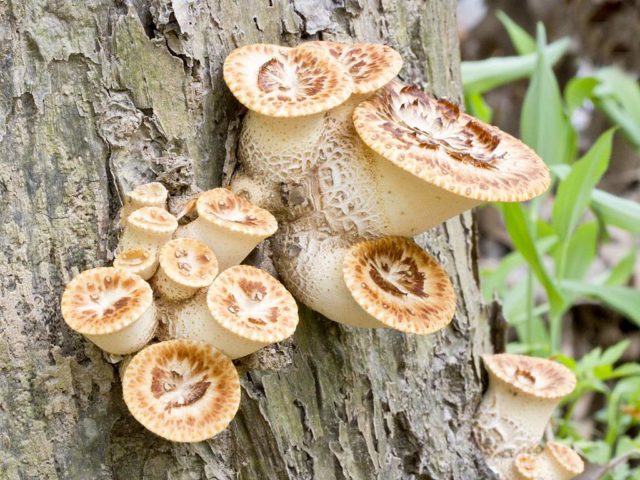
Scaly tinder fungus, edible
When to collect tinder fungus
Tinder mushrooms need to be collected in the spring, with the beginning of sap flow, and in the fall, when they, having prepared for wintering, have stocked up with useful substances. When preparing medicinal raw materials, preference should be given to specimens growing at high altitudes. Polypores with a cork tram can be cut with a knife, woody mushrooms will require a lot of effort and the use of an ax or saw. If the mushroom crumbles, it means that it is overripe and has lost its beneficial properties. The edible bushy varieties growing at the base of trees are best picked young, cutting out the whole group.
Why was the mushroom named tinder fungus
The name came from ancient times. Once upon a time, before the invention of matches, flint, consisting of flint, kresal and tinder was used to make a fire. With the help of a chair and a flint, a spark was struck, which was supposed to hit the tinder, a flammable material. Then the hard wood was kindled with the flaring tinder. A piece of cloth or cotton wool, dry moss, tree bark and woody mushrooms of a loose cork structure were used as tinder. Due to their ability to serve as tinder, these mushrooms were called tinder fungi.

Slice of tinder fungus and flint
Conclusion
Looking at a photo of a tinder fungus, one can endlessly wonder at the variety of manifestations of wildlife. This organism is the most important participant in the forest biocenosis, plays both a positive and a negative role in it. By destroying dead wood, tinder fungi contribute to its rapid decomposition and transformation into a nutritious substrate for other plants. At the same time, they harm forestry. Feeding on the juices of healthy plants, parasitic fungi lead them to death. And a person, being interested in the preservation of the forest, can influence the vital activity of tinder fungi, limit their distribution.
Photo of tinder fungi
Due to the large species diversity, it is impossible to present photos and descriptions of all edible and inedible tinder fungi. Many wildlife lovers consider these representatives of the mushroom kingdom to be very beautiful. The photos of tinder fungi with the names proposed below make it possible to be convinced of this and, possibly, cause a desire to get to know this kingdom better.
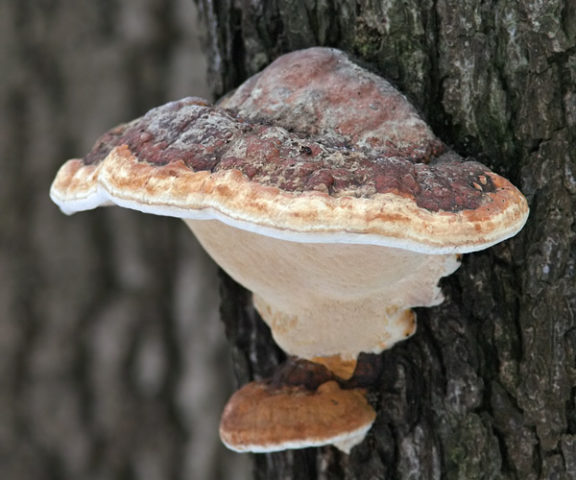
Fungus

Birch sponge
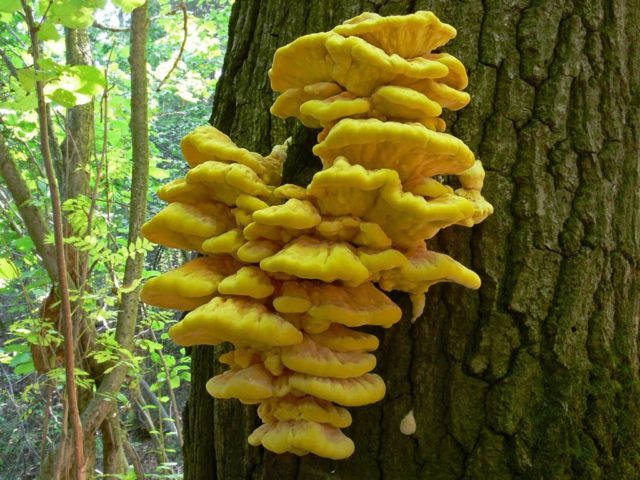
Tinder fungus sulfur-yellow

Meripilus giant

Umbrella polyporus
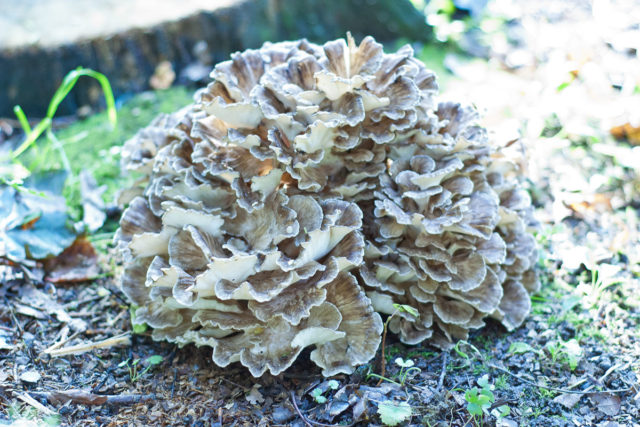
Deciduous griffin (ram mushroom)

The most beautiful climacodon
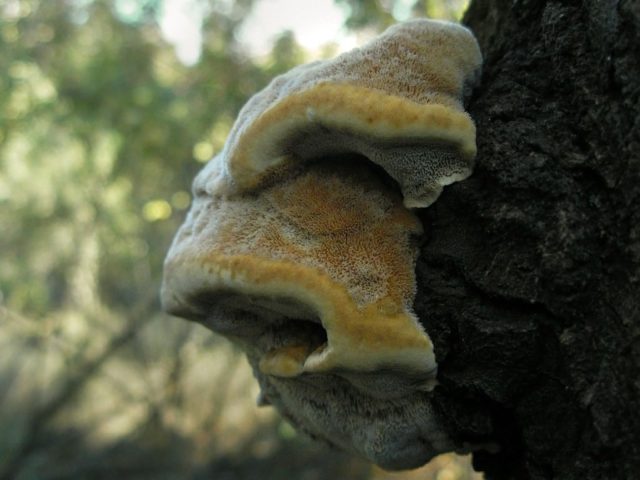
Fox tinder
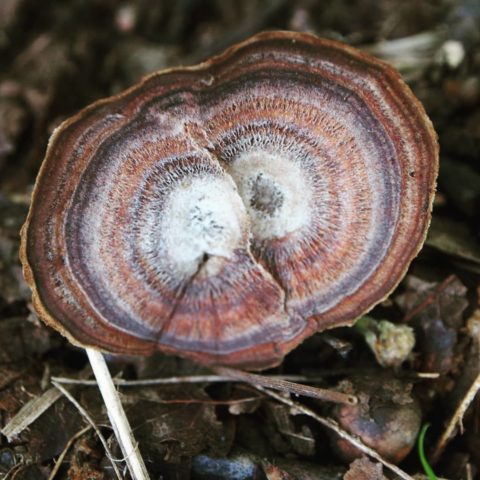
Sukhlyanka two-year
